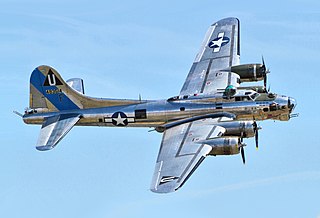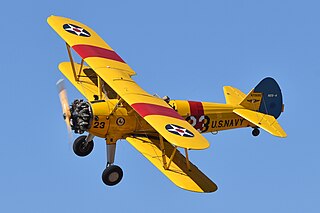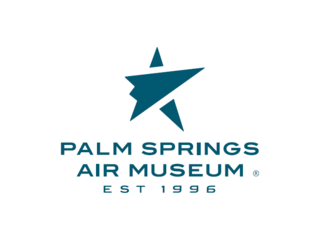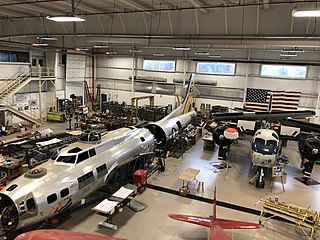
The Boeing B-17 Flying Fortress is an American four-engined heavy bomber aircraft developed in the 1930s for the United States Army Air Corps (USAAC). A fast and high-flying bomber of its era, the B-17 was used primarily in the European Theater of Operations and dropped more bombs than any other aircraft during World War II. It is the third-most produced bomber of all time, behind the American four-engined Consolidated B-24 Liberator and the German multirole, twin-engined Junkers Ju 88. It was also employed as a transport, antisubmarine aircraft, drone controller, and search-and-rescue aircraft.

The Vultee BT-13 Valiant is an American World War II-era basic trainer aircraft built by Vultee Aircraft for the United States Army Air Corps, and later US Army Air Forces. A subsequent variant of the BT-13 in USAAC/USAAF service was known as the BT-15 Valiant, while an identical version for the US Navy was known as the SNV and was used to train naval aviators for the US Navy and its sister services, the US Marine Corps and US Coast Guard.

The Pima Air & Space Museum is an aerospace museum in Tucson, Arizona, US. It features a display of nearly 400 aircraft spread out over 80 acres (32 ha) on a campus occupying 127 acres (51 ha). It has also been the home to the Arizona Aviation Hall of Fame since 1991.

The Stearman (Boeing) Model 75 is an American biplane formerly used as a military trainer aircraft, of which at least 10,626 were built in the United States during the 1930s and 1940s. Stearman Aircraft became a subsidiary of Boeing in 1934. Widely known as the Stearman, Boeing Stearman, or Kaydet, it served as a primary trainer for the United States Army Air Forces, the United States Navy, and with the Royal Canadian Air Force as the Kaydet throughout World War II. After the conflict was over, thousands of surplus aircraft were sold on the civilian market. In the immediate postwar years, they became popular as crop dusters and sports planes, and for aerobatic and wing walking use in air shows.

Palm Springs Air Museum is an aviation museum in Palm Springs, California. The 501(c)(3) nonprofit leases from the city 17 acres abutting Palm Springs International Airport.

Liberty Belle was a popular name for United States Army Air Forces (USAAF) aircraft during World War II; over two dozen known individual Boeing B-17 Flying Fortresses and Consolidated B-24 Liberators used the name.

Nine-O-Nine was a Boeing B-17G-30-BO Flying Fortress heavy bomber, of the 323d Bombardment Squadron, 91st Bombardment Group, that completed 140 combat missions during World War II, believed to be the Eighth Air Force record for most missions without loss to the crews that flew her. A different B-17G, painted to mimic the Nine-O-Nine, crashed at Bradley International Airport in Windsor Locks, Connecticut, in October 2019.

Sally B is the name of an airworthy 1945-built Boeing B-17G Flying Fortress. At 79 years old, she is the only airworthy B-17 based in Europe, as well as one of three B-17s preserved in the United Kingdom. The aircraft is presently based at the Imperial War Museum Duxford, in eastern England. Sally B flies at airshows in the UK and across Europe as well as serving as an airborne memorial to the United States Army Air Forces airmen who lost their lives in the European theatre during World War II.

Shoo Shoo Shoo Baby, originally Shoo Shoo Baby, is a Boeing B-17 Flying Fortress in World War II, preserved and currently in storage at the National Museum of the United States Air Force, awaiting transfer to the Smithsonian's National Air and Space Museum. A B-17G-35-BO, serial number 42-32076, and manufactured by Boeing, it was named by her crew for a song of the same name made popular by The Andrews Sisters, the favorite song of its crew chief T/Sgt. Hank Cordes. Photographs of the bomber indicate that a third "Shoo" was added to the name at some point in May 1944 when the original aircraft commander completed his tour of duty and was replaced by another pilot.

The Barksdale Global Power Museum is an aviation museum run by the United States Air Force on Barksdale Air Force Base near Bossier City, Louisiana. Hosted by the 2nd Bomb Wing, it maintains a large collection of military aircraft and historical artifacts that illuminate the early days of United States military aviation, the Barksdale base, and the formations of the 2nd Bomb Wing and the 8th Air Force.

Texas Raiders was an American Boeing B-17 Flying Fortress, a B-17G-95-DL built by Douglas Long Beach. In 1967, it was purchased by the Commemorative Air Force's Gulf Coast Wing "Texas Raiders" group, which maintained and flew the aircraft out of Conroe-North Houston Regional Airport in Conroe, Texas. The aircraft was destroyed on November 12, 2022, by a mid-air collision with a P-63 Kingcobra at an air show at Dallas Executive Airport, Texas, that killed all five occupants and the P-63 pilot.
This is a partial list of accidents and incidents involving the Boeing-designed B-17 Flying Fortress. Combat losses are not included except for a very few cases denoted by singular circumstances. A few documented drone attrition cases are also included.

Yankee Lady is a Boeing B-17 Flying Fortress, previously owned by the Yankee Air Museum of Van Buren Township, Michigan. Originally delivered to the U.S military in 1945, the plane did not see combat action; it was used by the United States Coast Guard for over a decade. Purchased by the museum in 1986, it has since been restored to a World War II configuration and is flown for flight experience rides and airshow appearances. The aircraft was sold to an unknown party in June 2024.

The 3205th Drone Group is a discontinued United States Air Force unit that operated obsolete aircraft during the 1950s as radio-controlled aerial targets for various tests. It was the primary post-World War II operator of surplus Boeing B-17G Flying Fortress aircraft, and also operated Lockheed F-80 Shooting Star and a few Boeing RB-47 Stratojet bombers that were converted into drone aircraft during the early years of the Cold War. It was last active with the Air Proving Ground Center, based at Eglin Air Force Base, Florida, where it was discontinued on 1 February 1961.

The Champaign Aviation Museum is an aviation museum in Urbana, Ohio. It is situated on the north end of Grimes Field municipal airport, roughly a mile from central Urbana. The museum is known primarily for its ongoing restoration of a B-17 Flying Fortress to flying condition. It is also a component of the National Aviation Heritage Area, a federally designated heritage area primarily centered around sites pertaining to the Wright brothers.

Boeing B-17G Flying Fortress No.44-83690 is a B-17 Flying Fortress heavy bomber currently undergoing restoration at the Museum of Aviation near Robins Air Force Base in Georgia. It was built as a B-17G-95-DL by the Douglas Aircraft Company and delivered for use on May 9, 1945. It was flown to Grissom Air Force Base for display as a museum piece in 1961. The plane was listed on the National Register of Historic Places in 1993. It was moved to the Museum of Aviation in August 2015.

The Erickson Aircraft Collection is an aviation museum located at the Madras Municipal Airport in Madras, Oregon.
The Mid America Flight Museum is an aviation museum located at the Mount Pleasant Regional Airport in Mount Pleasant, Texas.

















